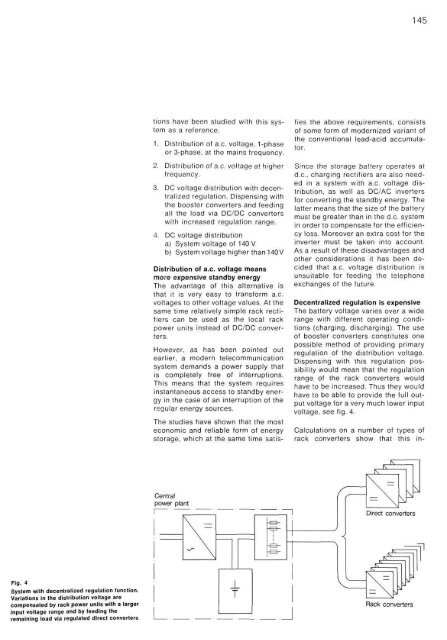geostationary telecommunications satellites electronic telephone set ...
geostationary telecommunications satellites electronic telephone set ...
geostationary telecommunications satellites electronic telephone set ...
Create successful ePaper yourself
Turn your PDF publications into a flip-book with our unique Google optimized e-Paper software.
145<br />
tions have been studied with this system<br />
as a reference.<br />
1. Distribution of a.c. voltage, 1-phase<br />
or 3-phase, at the mains frequency.<br />
2. Distribution of a.c. voltage at higher<br />
frequency.<br />
3. DC voltage distribution with decentralized<br />
regulation. Dispensing with<br />
the booster converters and feeding<br />
all the load via DC/DC converters<br />
with increased regulation range.<br />
4. DC voltage distribution<br />
a) System voltage of 140 V<br />
b) System voltage higher than 140V<br />
Distribution of a.c. voltage means<br />
more expensive standby energy<br />
The advantage of this alternative is<br />
that it is very easy to transform a.c.<br />
voltages to other voltage values. At the<br />
same time relatively simple rack rectifiers<br />
can be used as the local rack<br />
power units instead of DC/DC converters.<br />
However, as has been pointed out<br />
earlier, a modern telecommunication<br />
system demands a power supply that<br />
is completely free of interruptions.<br />
This means that the system requires<br />
instantaneous access to standby energy<br />
in the case of an interruption of the<br />
regular energy sources.<br />
The studies have shown that the most<br />
economic and reliable form of energy<br />
storage, which at the same time satisfies<br />
the above requirements, consists<br />
of some form of modernized variant of<br />
the conventional lead-acid accumulator.<br />
Since the storage battery operates at<br />
d.c, charging rectifiers are also needed<br />
in a system with a.c. voltage distribution,<br />
as well as DC/AC inverters<br />
for converting the standby energy. The<br />
latter means that the size of the battery<br />
must be greater than in the d.c. system<br />
in order to compensate for the efficiency<br />
loss. Moreover an extra cost for the<br />
inverter must be taken into account.<br />
As a result of these disadvantages and<br />
other considerations it has been decided<br />
that a.c. voltage distribution is<br />
unsuitable for feeding the <strong>telephone</strong><br />
exchanges of the future.<br />
Decentralized regulation is expensive<br />
The battery voltage varies over a wide<br />
range with different operating conditions<br />
(charging, discharging). The use<br />
of booster converters constitutes one<br />
possible method of providing primary<br />
regulation of the distribution voltage.<br />
Dispensing with this regulation possibility<br />
would mean that the regulation<br />
range of the rack converters would<br />
have to be increased. Thus they would<br />
have to be able to provide the full output<br />
voltage for a very much lower input<br />
voltage, see fig. 4.<br />
Calculations on a number of types of<br />
rack converters show that this in-<br />
Fig. 4<br />
System with decentralized regulation function.<br />
Variations in the distribution voltage are<br />
compensated by rack power units with a larger<br />
input voltage range and by feeding the<br />
remaining load via regulated direct converters
















